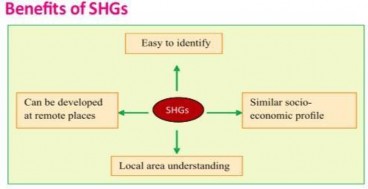4.4. Benefits of SHGs

♤ According to some estimates, about 46 million rural poor women are mobilized through SHGs architecture. These organizations have been an effective vehicle, especially in providing financial
intermediation solutions for unbanked rural women.
♤ The socio-economic benefits include economic self independence, participation in village affairs and awareness about education.
♤ Under National Rural Livelihood Mission, special

attention has been given to women living below poverty line (BPL). The scheme has also focused on capacity building and institutionalization of SHGs. It has also helped in social mobilization, institution building, communization and creation of human resource.
♤ Regular process of group meetings helps women build social capital. It raises their status in the family and the society.
♤ Economic empowerment helps them take decision making role in the family. Thus help them break shackles of patriarchy.
♤ A research has also shown that Women practicing ‘participatory learning and action’
showed 49 % reduction in maternal mortality and 33 % reduction in neonatal mortality.
